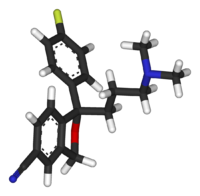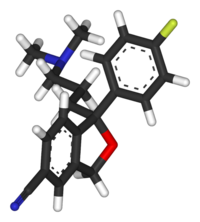Citalopram
From Wikipedia, the free encyclopedia
 |
|
|
Citalopram
|
|
| Systematic (IUPAC) name | |
| 1-[3-(dimethylamino)propyl]-1-(4-fluorophenyl)-1,3-dihydroisobenzofuran-5-carbonitrile | |
| Identifiers | |
| CAS number | |
| ATC code | N06 N06AB10 |
| PubChem | |
| DrugBank | |
| ChemSpider | |
| Chemical data | |
| Formula | C20H21FN2O |
| Mol. mass | 324.392 g/mol |
| Pharmacokinetic data | |
| Bioavailability | 80% |
| Metabolism | hepatic (CYP3A4 & CYP2C19) |
| Half life | 35 hours |
| Excretion | Mostly as unmetabolized Citalopram, partly DCT and traces of DDCT in urine |
| Therapeutic considerations | |
| Pregnancy cat. |
C(US) |
| Legal status |
℞ Prescription only |
| Routes | Oral |
Citalopram is an antidepressant drug used to treat major depression associated with mood disorders. It is also used on occasion in the treatment of body dysmorphic disorder and anxiety.
Citalopram belongs to a class of drugs known as selective serotonin reuptake inhibitors (SSRIs). It is sold under the brand-names Celexa (U.S. and Canada, Forest Laboratories, Inc.), Cipramil (Australia, Brazil, Finland, Germany, Ireland, Sweden, United Kingdom), Citrol, Seropram, Talam (Europe and Australia), Citabax, Citaxin (Poland), Citalec (Slovakia), Recital (Israel, Thrima Inc. for Unipharm Ltd.), Zetalo (India), Celapram, Ciazil (Australia, New Zealand), Zentius (South America, Roemmers), Ciprapine (Ireland), Cilift (South Africa), Citox (Mexico), Citopam, Akarin (Denmark, Nycomed), and Cipram (Denmark, H. Lundbeck A/S).
Contents |
[edit] History
Citalopram (sī-'tal-ǝ-וpram)[1] was originally created in 1989,[2] by the pharmaceutical company Lundbeck. The patent expired in 2003, allowing other companies to legally produce generic versions.
Lundbeck has recently released an updated formulation called escitalopram (also known as Cipralex or Lexapro), which is the S-enantiomer of the racemic citalopram (see below), and acquired a new patent for it. In the United States, Forest Laboratories licenses the rights for both Celexa and Lexapro from Lundbeck, which is based in Denmark.
[edit] Indications
[edit] Approved
Citalopram is used to treat the symptoms of major depression, social anxiety disorder and panic disorder.
Citalopram is a Pgp substrate and is actively transported by that protein from the brain. The efficacy of citalopram in people possessing a certain version of Pgp (genetic TT-allele) is likely to be diminished. This suggests that in non-responders to citalopram a switch to antidepressant which is not a Pgp substrate, such as fluoxetine (Prozac, Fontex) or mirtazapine (Remeron)—but not to venlafaxine (Effexor), amitriptyline (Elavil) or paroxetine (Paxil), which are Pgp substrates—may be beneficial.[3]
[edit] Unapproved, Off-label and Investigational
Citalopram has been found to significantly reduce the symptoms of diabetic neuropathy,[4] and premature ejaculation.[5] There is also evidence that citalopram may be effective in the treatment of post-stroke pathological crying.[6]
While on its own Citalopram is less effective than amitriptyline in the prevention of migraines, in refractory cases combination therapy may be more effective.[7]
[edit] Side effects and drug interactions
Citalopram is generally considered safe and well-tolerated in the therapeutic dose range of 20 to 60 mg/day. A doctor must always monitor a patient taking an SSRI like citalopram. Distinct from some other agents in its class, citalopram exhibits linear pharmacokinetics and minimal drug interaction potential, making it a better choice for the elderly or comorbid patients.[8]
Citalopram should be taken with caution when using St John's wort, as resulting drug interactions could be adverse.[9] This may be caused by compounds in the plant extract reducing the efficacy of the hepatic cytochrome P450 enzymes that process citalopram.[10] It has also been suggested that such compounds, including hypericin, hyperforin and flavonoids, could have SSRI-mimetic effects on the nervous system, although this is still subject to debate.[11] One study found that Hypericum extracts had similar effects in treating moderate depression as citalopram, with fewer side effects.[12]
Citalopram can have a number of adverse effects. In clinical trials, over 10% of patients reported one or more of the following side effects: fatigue, drowsiness, dry mouth, increased sweating (hyperhidrosis), trembling, headache, dizziness, sleep disturbances, insomnia, cardiac arrhythmia, hallucinations, blood pressure changes, nausea and/or vomiting, diarrhea, heightened anorgasmia in females, impotence and ejaculatory problems in males. In rare cases (around over 1% of cases), some allergic reactions, convulsions, mood swings, anxiety and confusion have been reported. Also sedation may be present during treatment of citalopram. If this occurs it is advisable to take the dose at bedtime instead of in the morning.[citation needed]
One rare side effect of antidepressant medications is bruxism (teeth grinding). However there is no evidence directly implicating Citalopram with teeth grinding.[13]
When taken with Prilosec, the clearance of Citalopram may be reduced, leading to higher blood levels of Citalopram. Prilosec inhibits the CYP450 2C19 enzyme, one of the two primary enzymes responsible for the metabolism of Citalopram. Dosage adjustments may be needed due to this effect.
Citalopram and other SSRIs have been shown to cause a preoccupation with sexual content in some patients, both males and females.[clarification needed][14]
Citalopram is contraindicated in individuals taking MAOIs. The drug considered relatively safe in overdose, although fatal cases of dosages 840 mg to 1960 mg have been reported.[15]
SSRI discontinuation syndrome has been reported when treatment is stopped. Tapering off citalopram therapy, as opposed to abrupt discontinuation, is recommended in order to diminish the occurrence and severity of discontinuation symptoms.
[edit] Stereochemistry
Citalopram has one stereocenter, to which a 4-fluorophenyl group and an N,N-dimethyl-3-aminopropyl group bind. Due to this chirality, the molecule exists in (two) enantiomeric forms (mirror images). They are termed S-(+)-citalopram and R-(−)-citalopram.
 |
 |
 |
 |
| S-(+)-citalopram | R-(−)-citalopram |
Citalopram is sold as a racemic mixture, consisting of 50% R-(−)-citalopram and 50% S-(+)-citalopram. Only the S-(+) enantiomer has the desired antidepressant effect. Lundbeck now markets the S-(+) enantiomer, the generic name of which is escitalopram. Whereas citalopram is supplied as the hydrobromide, escitalopram is sold as the oxalate salt (hydrooxalate).[16] In both cases, the salt forms of the amine makes these otherwise lipophilic compounds water-soluble.
[edit] References
- ^ "citalopram". Merriam-Webster, Incorporated. http://medical.merriam-webster.com/medical/citalopram. Retrieved on 2008-10-13.
- ^ Dorell K, Cohen MA, Huprikar SS, Gorman JM, Jones M (2005). "Citalopram-induced diplopia". Psychosomatics 46 (1): 91–3. doi:. PMID 15765832.
- ^ Uhr M, Tontsch A, Namendorf C, Ripke S, Lucae S, Ising M, Dose T, Ebinger M, Rosenhagen M, Kohli M, Kloiber S, Salyakina D, Bettecken T, Specht M, Pütz B, Binder EB, Müller-Myhsok B, Holsboer F (2008). "Polymorphisms in the Drug Transporter Gene ABCB1 Predict Antidepressant Treatment Response in Depression". Neuron 57 (2): 203–9. doi:. PMID 18215618.
- ^ Sindrup SH, Bjerre U, Dejgaard A, Brøsen K, Aaes-Jørgensen T, Gram LF (1992). "The selective serotonin reuptake inhibitor citalopram relieves the symptoms of diabetic neuropathy". Clin. Pharmacol. Ther. 52 (5): 547–52. PMID 1424428.
- ^ Atmaca M, Kuloglu M, Tezcan E, Semercioz A (2002). "The efficacy of citalopram in the treatment of premature ejaculation (prem-e): a placebo-controlled study". Int. J. Impot. Res. 14 (6): 502–5. doi:. PMID 12494286.
- ^ Andersen G, Vestergaard K, Riis JO (1993). "Citalopram for post-stroke pathological crying". Lancet 342 (8875): 837–9. doi:. PMID 8104273.
- ^ Rampello L, Alvano A, Chiechio S, et al (2004). "Evaluation of the prophylactic efficacy of amitriptyline and citalopram, alone or in combination, in patients with comorbidity of depression, migraine, and tension-type headache". Neuropsychobiology 50 (4): 322–8. doi:. PMID 15539864.
- ^ Keller MB (2000). "Citalopram therapy for depression: a review of 10 years of European experience and data from U.S. clinical trials". The Journal of clinical psychiatry 61 (12): 896–908. PMID 11206593. http://www.biopsychiatry.com/citalopram.html.
- ^ Karch, Amy (2006). 2006 Lippincott's Nursing Drug Guide. Philadephia, Baltimore, New York, London, Buenos Aires, Hong Kong, Sydney, Tokyo: Lippincott Williams & Wilkins. ISBN 1-58255-436-6.
- ^ http://www.medsafe.govt.nz/Profs/PUarticles/sjw.htm accessed Feb 27 2009
- ^ http://www.umm.edu/altmed/articles/st-johns-000276.htm accessed Feb 27 2009
- ^ M. Gastpar, et al. Comparative Efficacy and Safety of a Once-Daily Dosage of Hypericum Extract STW3-VI and Citalopram in Patients with Moderate Depression: A Double-Blind, Randomised, Multicentre, Placebo-Controlled Study. 2006. Pharmacopsychiatry; 39: 66-75 DOI: 10.1055/s-2006-931544. http://www.thieme-connect.com/ejournals/abstract/pharmaco/doi/10.1055/s-2006-931544 accessed Feb 27 2009
- ^ "Bruxism/Teeth grinding". Mayo Clinic. 2007-05-18. http://www.mayoclinic.com/health/bruxism/DS00337/DSECTION=3. Retrieved on 2007-07-25.
- ^ Clayton A, Keller A, McGarvey EL (2006). "Burden of phase-specific sexual dysfunction with SSRIs". Journal of affective disorders 91 (1): 27–32. doi:. PMID 16430968.
- ^ "Citalopram Hydrobromide Brand name: Celexa Drug monograph; Symptoms and Treatment of Overdosage". Internet Mental Health. August 1999. http://www.mentalhealth.com/drug/p30-c04.html#Head_12. Retrieved on 2007-07-25.]
- ^ Celexa.com
[edit] External links
- Celexa product page on Forest Laboratories web site
- Cipramil Patient Information Leaflet Cipramil Patient Information Leaflet
|
|||||||||||||||||||||||||||||||||||||


